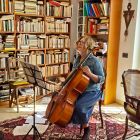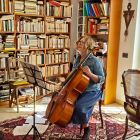Burne-Jones and his magnificent mosaics
I want big things to do and vast spaces and for common people to see them and say oh! only oh!. For the renowned 19th-century British pre-Raphaelite artist Sir Edward Coley Burne-Jones that large space, here in Rome, did materialise.
The story of the monumental mosaics he designed for the interior walls of the church of St Pauls within-the-Walls on Via Nazionale is a story of remarkable determination and patience, with a cast of eminent characters woven into the account who, with a bit of poetic licence on dates, might just have stepped out of the Gilded Age pages of an Edith Wharton novel. There were Astors and Morgans and Lorillards and Schermerhorns.
Throughout the mid-1800s, the momentum of Grand Tour American travellers was on the increase, with more and more of them making a beeline for Rome. Already on the scene to greet them was a growing number of young resident artists from across the Atlantic, and others, mostly the very wealthy, who had put down roots in the citys grand palazzi. For transients and settlers alike, the matter of Protestant worship proved a growing issue. By papal decree, these American non-Catholics either had to make their arrangements outside the walls of Rome or otherwise severely restrict their devotions to within the United States legation, under the shelter of the Stars and Stripes. In his book Americas Rome, author William L. Vance describes the almost cat-and-mouse subterfuge that went on, as clandestine quarters were offered by sympathetic foreign residents. But the papal authorities were on to this ploy and ever ready to pounce and evict the culprits. As Vance observes, [it] constituted a form of persecution. And, quite probably, he adds, it helped contribute to the severing of diplomatic ties between the US and the Papal States in 1867.
Three years later, with the seizure of Rome and wresting of power from the pope, the heat was finally off and the Protestant community could at last focus on building churches of its own. The Americans moved forward smartly: within three years land was purchased for $18,000 at the corner of Via Nazionale and Via Napoli, once the domain of nuns tending vineyards, and the cornerstone was formally laid for what would later be designated as St. Pauls
within-the-Walls. The first and most vital task was, of course, to build the church itself. For the tireless Robert J. Nevin, St Pauls first rector, it signalled the beginning of arduous years of fund-raising. As Nevins efforts yielded the requisite money, the building programme went forward speedily under architect George Street, and the church was consecrated six years later, in 1876.
Once the church was completed, attention could be diverted to embellishment of the interiors. Sculptural detail came first, along with stained glass windows. The dream was to have mosaics covering the east end of the new church, but nothing could be contemplated until a benefactor had been found. This occurred in 1881 when Junius Spencer Morgan, father of the famed financier J.P., stepped in. With that, Street promptly took the next bold step: he turned to the great Burne-Jones.
Burne-Jones, then in his late 40s, was riding high in his native England. Together with Sir Lawrence Alma-Tadema, he was one of his countrys most eminent pre-Raphaelite painters, famed for portraying heavy-lidded, ruby-lipped beauties with thick tangles of hair and elaborate mediaeval gowns. His collaboration with William Morris in designing rich, stained-glass windows propelled him even further into the limelight. Yet as one critic recently noted, Burne-Jones had mostly concentrated on mid-scale works. This project was on an entirely new scale for him. And furthermore, he had never before worked in the medium of mosaics.
Nevertheless, the choice was fitting. Burne-Jones loved Italy and had travelled here frequently. Americans figured strongly among his many fervent admirers. He was seduced by the bait of such a large, ambitious project. And lastly, America in that period had no tradition in mural decoration of its own. Burne-Jones therefore undertook this sweeping new commission in Rome.
With Morgan money secured for the first stage of the four-part project, the artist went to work in his English studio on preparatory studies for Christ Enthroned in the Heavenly Jerusalem, which would be installed in the semi-dome of the 8.7-m wide apse. The three-way coordination between London, Rome and Venice, where all the mosaic chips tesserae were actually made and assembled, was laborious to say the least. Burne-Jones briefly lost his drive early on, and Nevin had to rush to London to coax him forward. Cartoons were sent down to Venice and tesserae up to London. Each Venetian artisan had been assigned a patch of the overall cartoon. Samples were dispatched to London for the approval of the artist, who thundered despair when the translation from cartoon to mosaic was not as faithful as he wanted. His studio assistant Thomas Rooke, ever the trouble-shooter, rushed to Venice to put things right and to scold them, pitch into them, bully them, curse until at last it was as the maestro wished it: the mystical, beardless Christ emerged, stern-looking yet compassionate, swathed in stylised white robes, surrounded by a cluster of winged seraphim and flanked by angels and archangels in niche-like sentry posts. So large and bold and glittering in subtle church lighting, this composition captured and still captures the instant attention of all who set foot inside St Pauls within-the-Walls. Four years in the works, the opus was unveiled on Christmas day of 1885.
It was time to focus on phase two. Or perhaps more accurately, phases two and three. Burne-Joness Annunciation is set in the stark, drab brown hues favoured by the northern Europeans, with the Madonna and Archangel Gabriel standing in a dark and barren desert, underlining the message that Christ had yet to appear. It took Burne-Jones two years to complete the Annunciation cartoon and get it off to Venice for translation, and another two years for it to be mounted in mosaic form. Meanwhile, an anonymous donor had volunteered the money to execute Tree of Life, which was completed by 1893. This work, destined for the arch preceding the semi-dome, is in far richer colours. The trees branches are spread wide, with a cross-less Jesus positioned in the foreground. Its a mystical thing, Burne-Jones explained, Christ hanging with outspread arms but not crucified: the cross is turned into a big tree. It was said to be the artists favourite of all. Adam and Eve are chastely draped and Eve bears the tell-tale signs of pre-Raphaelite style in her thick mane of russet-coloured hair. With savings on expenses ever a consideration, Nevin had scaffolding erected only once to mount both of the mosaic works, and they were unveiled simultaneously in November 1894.
By that time, the artist was 61 years old and would live only another four years. Earthly Paradise was to be the final composition in the quartet and the one in which, bowing to longstanding tradition, benefactors and devoted friends of St Pauls within-the-Walls would be acknowledged. It is a custom that holds over even to this day, one striking example being the cathedral of St John the Divine in New York City, where young Harlem stonecutters were given free rein to shape the faces of their contemporary heroes, from Martin Luther King to legendary black basketball players, for the adornment of the cathedrals faade.
Earthly Paradise was earmarked for the lower wall of the apse, and this time Nevin and his heirs were the benefactors. In his cartoon, Burne-Jones garbed his subjects in rich robes and you can pick out some very familiar faces of the day: Giuseppe Garibaldi (St James of Spain), Ulysses S. Grant (St Patrick), Abraham Lincoln (St Andrew). But the artist had got no further than preliminary studies when he died in 1898. Nevin turned, in 1905, to his faithful studio assistant Rooke, pleading with him to finish the job. Nevin was growing old and was anxious to see completion. There were hesitations, but Rooke finally went to work. Mary D. Astor made it into portraiture, as did Junius Spencer Morgan and Nevin himself, as well as Burne-Jones and his wife Lady Georgiana. With the installation of Earthly Paradise in December 1907, the great cycle was at last fulfilled.
The one note of sadness about this 26-year project was that the great artist, who so loved Italy and was so pleased to have worked on such a vast scale, made not one trip south to see his dreams in the making. Had he done so, perhaps he too would have said oh!.
St Pauls within-the-Walls. Via Nazionale, corner Via Napoli.
Picture: "Christ Enthroned in the Heavenly Jerusalem" was the first of Burne-Jones's mosaics to decorate St Paul's.





















